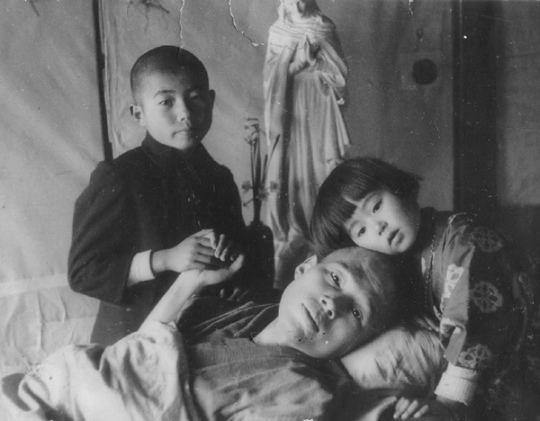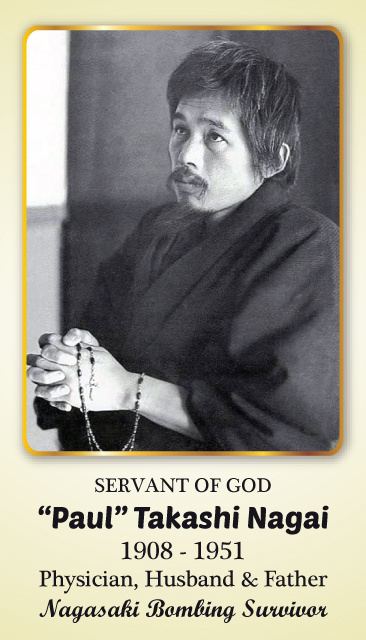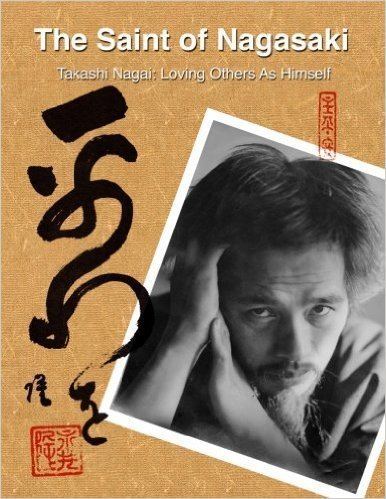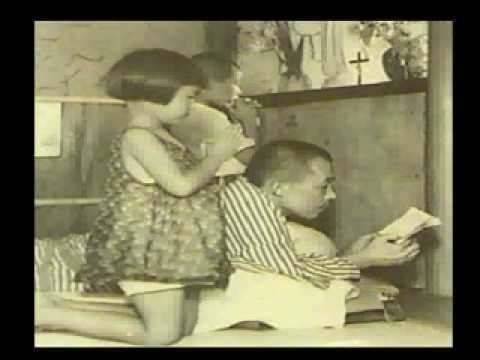Nationality Japan Name Takashi Nagai | Role Physician | |
 | ||
Died May 1, 1951, Nagasaki Prefecture, Japan Books The bells of Nagasaki, Leaving My Beloved Children Behind Children Makoto Nagai, Ikuko Nagai, Kayano Nagai, Sasano Nagai | ||
Dr takashi nagai a loving physician
Takashi Nagai (永井 隆, Nagai Takashi, 3 February 1908, Matsue – 1 May 1951, Nagasaki) was a physician specializing in radiology, a convert to Roman Catholicism, and a survivor of the atomic bombing of Nagasaki. His subsequent life of prayer and service earned him the affectionate title "saint of Urakami" and has subsequently been honoured with the title of Servant of God, the first step towards Catholic sainthood.
Contents
- Dr takashi nagai a loving physician
- Takashi nagai rare footage
- Early years
- Life in Nagasaki
- Conversion to Catholicism
- Sino Japanese War
- World War II
- Relief Activities
- Postwar years
- Death
- Legacy
- Use of Nuclear Power
- Works
- Media
- References
Takashi nagai rare footage
Early years

Takashi Nagai was born in 1908 on 3 February (2 February, according to occidental time) after a difficult birth that endangered both his own and his mother's life. His family included doctors. His father, Noboru Nagai, was trained in Western medicine; his paternal grandfather, Fumitaka Nagai, was a practitioner of traditional herbal medicine. His mother, Tsune, was the descendant of an old family of samurai. In Japanese, Takashi means "nobility".

Nagai was raised in the rural area of Mitoya and raised in according to the teachings of Confucius and the Shinto religion. In 1920, he commenced his secondary studies at Matsue High School boarding at his cousins' home, not far from Matsue. Occidental sciences and the materialistic spirit were dominant among his professors. He became increasingly interested with the surrounding atheism. While attending school, he took notice of a Christian teacher who worked there, and came to hear the story of the teachings of Christ from this teacher.
Life in Nagasaki

In April 1928, he joined the Nagasaki Medical College. The reason he chose the college is unclear, as he did not explain it clearly to his parents, siblings, friends or classmates, nor did he write anything about it.

During his studies he embarked upon the spiritual journey that would eventually lead him from atheism to Catholicism. The college was located 500 meters from Urakami Cathedral, but Nagai had faith only in science, humanity and Japan. He joined the Araragi, a poetry group founded by Mokichi Saito and the university basketball team (he measured 1.71 m and weighed 70 kg).

In 1930, a letter from his father had informed him that his mother was seriously ill: having become a victim to brain haemorrhage, she was conscious but was unable to speak. He went to her bedside. She looked intensely into his eyes and died soon after (29 March). One of his professors spoke about the philosopher and scientist Blaise Pascal, quoting a sentence from the Pensées: "Man is only a reed, the weakest thing in nature; but he is a thinking reed." He began then to read the Pensées and ponderate on human life and existence. During 1931, he constantly read Pascal's works and wondered about Christian life. He became interested in Christianity while boarding with the Moriyama family, who for seven generations had been the hereditary leaders of a group of Kakure Kirishitans in Urakami. Sadakichi Moriyama lived with his wife and daughter, Midori, who was a primary school teacher in a nearby city. Takashi learned that the construction of the cathedral was financed by poor Christian farmers and fishermen.

In 1932, he passed his examinations. He was supposed to deliver an address at a graduation ceremony, but 5 days before the ceremony, he became intoxicated with alcohol in a farewell party held at a Chinese restaurant "Tsutenkaku" and had returned completely soaked with water from the rain. He slept without drying himself. The next morning, Nagai contracted a disease of the right ear (signs of meningitis), which made him depressed and made him partially deaf. He could not practice medicine and agreed to turn to radiology research.
On 24 December, Sadakichi Moriyama invited Nagai to participate in a midnight Mass. In the cathedral, Takashi was impressed by the people in prayer, their singing, their faith and the sermon. He would later say: "I felt somebody close to me whom I did not still know." The next night, Sadakichi's daughter Midori was struck down by an acute appendicitis. Nagai made a quick diagnosis, telephoned the surgeon at the hospital and carried Midori there on his back through the snow. The operation was successful; Midori, survived.
In January 1933, Takashi began his military service. Before leaving for the campaign of Manchukuo, he did his training in Hiroshima during which a package was sent to him: it was Midori offering him gloves, socks and a Catholic catechism.
In Manchuria, Nagai cared for the wounded and the sanitary service. He was strongly shaken in his faith in Japanese culture when had seen for himself the exactions of the Japanese soldiers and their brutality towards the Chinese civilian population. Upon his return, he continued his reading of the Catholic catechism, the Bible, and the Pensées of Blaise Pascal. He met with a priest, Father Matsusaburo Moriyama, whose father had been deported to Tsuwano (Shimane Prefecture) for his faith, along with many other Christian villagers in Urakami by the Meiji Government from the 1860s to the 1870s (Urakami Yoban Kuzure). Eventually, Nagai's spiritual progress took a decisive turn when he thought about Pascal's words: "There is enough light for those who only desire to see, and enough obscurity for those who have a contrary disposition."
Conversion to Catholicism
On 9 June 1934, Nagai received baptism in the Catholic faith and chose the Christian first name, Paul. Thus he joined the Catholic community, among whom the life of the Japanese saint Paul Miki strongly marked him. Then he proposed marriage to Midori; she accepted. In August 1934, a Wednesday, at 7 a.m., during the usual first mass in the cathedral of Urakami, the wedding of Maria Midori Moriyama and Paul Takashi Nagai was celebrated in the presence of the priest and of two witnesses. Of their union were born four children: a boy, Makoto (3 April 1935 - 4 April 2001) and three daughters, Ikuko (7 July 1937 - 1939), Sasano who died shortly after her birth, and Kayano (18 August 1941 – 2 February 2008).
Takashi received the sacrament of confirmation in December 1934. Midori was president of the association of the women of the Urakami district. Takashi became a member of the Society of Saint Vincent de Paul (SSVDP), discovered its founder, Frédéric Ozanam, and his writings, and visited his patients and the poor, to whom he brought assistance, comfort and food. From 1931-36, Father Maximilian Kolbe resided in a suburb of Nagasaki, where he started a monastery. Takashi met him several times.
Sino-Japanese War
The day after the birth of his first daughter Ikuko, the war between Japan and China broke out with no declaration. Takashi was mobilized as surgeon in the service of the 5th division. He suffered from the harsh winter in China but also in view of the distress of all victims of this war, civilians and soldiers, Chinese and Japanese, caring for the wounded and thinking about justice and peace. On 4 February 1939, he received news of the death of his father and that of his daughter Ikuko. He remained in China until 1940. Upon his return, he continued his studies at the college.
World War II
After Japan declared war on the United States on 8 December 1941, Nagai had a somber presentiment: his city could be destroyed during this war. He obtained his doctorate in 1944. On 26 April 1945, an air raid on Nagasaki left numerous victims. The hospital was overwhelmed. Takashi spent his days and nights serving the wounded in his radiology department. In June 1945, he was diagnosed with leukemia and given a life expectancy of three years. This disease was probably due to his exposure to X-rays during radiological examinations which he performed by direct observation, since films were not available any more during this war period. He spoke to Midori about his disease, and she said to Nagai, "Whether you live or die, it is for God's glory."
In the evening of 6 August, Nagai learned that an atomic bomb had been dropped by the Americans on Hiroshima. With Midori, he decided to take their children away to Matsuyama, 6 km away in the countryside, accompanied by Midori's mother.
Relief Activities
On 9 August 1945, at 11:02 am, the second atomic bomb launched by the Americans on Japan struck Nagasaki. At the time of the atomic bombing, Dr. Nagai was working in the radiology department of Nagasaki Medical College Hospital. He received a serious injury that severed his right temporal artery, but joined the rest of the surviving medical staff in dedicating themselves to treating the atomic bomb victims, and later wrote a 100-page medical report about his observations.
On 11 August, he found his house destroyed and his wife dead. Her maiden name was Maria Midori Moriyama. Paul Takashi Nagai had her married name inscribed on the cross at her grave: "Marina Nagai Midori, died on August 9, 1945, at age 37". On 8 September 1945, Nagai was found to be seriously affected by the wound. He was confined to bed for a month, with death for a time seeming close. The bleeding from his injury did not stop despite the efforts of doctors and nurses. Nagai had Cheyne-Stokes respiration, the sign of near death. Eventually, his bleeding stopped. According to Nagai, when he drank water taken from Lourdes in Honkawachi, where Fr. Kolbe had founded a monastery, he heard a voice urge him to ask an intercession from the priest.
Postwar years
He returned to the district of Urakami (the epicenter of the bomb) on 15 October 1945. He had a small hut built from pieces of his old house. He remained there with his two surviving children (Makoto and Kayano), his mother-in-law and two other relatives. This hut measured a little more than six tatami. In 1947, the local Society of Saint Vincent de Paul (SSVDP) built a simple two-tatami teahouse-like structure for him. Nagai named it "Nyokodo" (如己堂, Nyoko-dō to, literally "As-Yourself Hall", after Jesus' words, "Love your neighbor as yourself." He styled it as a hermitage and spent his remaining years in prayer and contemplation.
For six months, he observed mourning for Midori and let his beard and hair grow. On 23 November 1945, a mass was celebrated, in front of the ruins of the cathedral, for the victims of the bomb. Takashi gave a speech filled with faith, comparing the victims to a sacred offering to obtain peace. In the following years, Nagai resumed teaching and also began to write a number of books. The first of these, The Bells of Nagasaki, was completed by the first anniversary of the bombing. Although he failed to find a publisher at first, eventually it became a best-seller and the basis for a top box-office movie in Japan. In July 1946, he collapsed on the station platform. Now disabled, he was henceforth confined to bed.
In 1948, he used 50,000 yen paid by "Kyushu Times" to plant 1,000 three-year-old cherry trees in the district of Urakami to transform this devastated land into a "Hill of Flowers". Although some have been replaced, these cherry trees are still called "Nagai Senbonzakura" ("1,000 cherry trees of Nagai") and their flowers decorate the houses of Urakami in spring. By 2010, the numbers of these cherry trees have reduced to only about 20 due to aging and other causes.
On 3 December 1949, he was made freeman of the city of Nagasaki. He received a visit from Helen Keller in October 1948. He was also visited, in 1949, by Emperor Hirohito and by Cardinal Gilroy of Australia, a papal emissary.
Death
On 1 May 1951, he asked to be transported to the college hospital so that the medical students could observe the last moments of a man preparing to die from leukemia. He prolonged the day of hospitalization to wait for the statue of Our Lady, a gift from the Italian Catholic Medical Association.
Until the evening, his condition seemed stable. However, around 9:40pm, Nagai complained of dizziness and become unconscious. After two injections of cardiotonics, he regained his consciousness and prayed "Jesus, Mary, Joseph, into your hands, I entrust my soul." Then he took the cross from the hand of his son Makoto, who rushed into the room, and shortly after he shouted the words "Please pray!" Nagai breathed his last: it was 9:50 pm. He died at the age of 43. On the following day, his body underwent an autopsy at the hospital according to his will. His spleen had swelled to 3,410g (normal weight: 94g), and his liver weighed 5,035g (normal weight: 1,400g).
On 3 May, his funeral Mass was celebrated by Bishop Paul Aijirō Yamaguchi in front of the cathedral. On 14 May, an official ceremony took place in memory of Nagai. An estimated 20,000 attended. The city of Nagasaki observed one minute of silence while the bells of all the religious buildings rang. His remains were interred in the Sakamoto international cemetery.
Legacy
His "Nyokodo", with the addition of a library, became a museum in 1952: the Nagasaki City Nagai Takashi Memorial Museum; after undergoing restoration in 2000, it is managed today by Tokusaburo Nagai, the grandson of Takashi Nagai and son of Makoto Nagai.
The Dr. Takashi Nagai Memorial Museum is in Unnan City, Shimane Prefecture, where he spent his childhood.
His name was added to the Monument to the X-ray and Radium Martyrs of All Nations erected in Hamburg, Germany.
In 1991, Takashi Nagai Peace Award founded.
In Nagasaki, with the purpose of annually awarding individuals and/or organizations, both domestic and overseas, for their contributions to world peace through the improvements and developments of medicare for hibakusha and related social welfare, the Takashi Nagai Memorial Nagasaki Peace Award was founded.
On 1 April 2003, for the succession of Nagai's spirit and a center to offer medical care for domestic and overseas hibakusha, the Nagai Takashi Memorial International Hibakusha Medical Center was founded at Nagasaki University Hospital.
Shunichi Yamashita, the director of the center, who was appointed as an adviser to Fukushima prefecture on radiation exposure after the Fukushima Daiichi nuclear disaster, wrote:
"I myself is just a younger alumnus of the same university, I found Nagai Takashi Memorial International Hibakusha Medical Center at Nagasaki University Hospital. Furthermore, by founding the Takashi Nagai Memorial Nagasaki Peace Award as an international activity of Nagasaki Association for Hibakushas' Medical Care, I am making an effort in order to honor the doctor for a long time succeeding the last wishes of those who knows the doctor like the late Soshino Hisamatsu, the director of nursing service department."
In Korea in 2004, the Most Rev. Paul Moon-hee Rhee, then Archbishop of Daegu, founded the Korean Association of "Love Your Neighbor as Yourself".
Use of Nuclear Power
Although Nagai opposed the use of nuclear weapons, he hoped atomic energy might be used for peaceful purposes. At the end of "Atomic Bomb Rescue and Relief Report", he writes:
"We should utilize the principle of the atomic bomb. Go forward in the research of atomic energy contributing to the progress of civilization. A misfortune will then be transformed to good fortune. The world civilization will change with the utilization of atomic energy. If a new and fortunate world can be made, the souls of so many victims will rest in peace."
Works
Nagai left behind a voluminous output of essays, memoirs, drawings, and calligraphy on various themes including God, war, death, medicine, and orphanhood. These enjoyed a large readership during the American occupation of Japan (1945–52) as spiritual chronicles of the atomic bomb experience. His books have been translated into numerous languages, including Chinese, Korean, French, and German. Only three of his literary works are currently available in English: We of Nagasaki, a compilation of atomic-bomb victim testimonies edited by Nagai; The Bells of Nagasaki (trans. William Johnston); and Leaving My Beloved Children Behind (trans. Maurice M. Tatsuoka and Tsuneyoshi Takai). His works were recently republished in new Japanese editions by Paulist Press.
Much of Nagai's writing is spiritual, consisting of Christian reflections on the experience (or, just as often, imagined future experience) of himself and the people around him, especially his children, in the aftermath of the war. His intensely personal meditations are often addressed to his children or to God, and he works out his own spiritual issues on the page as he writes in a visceral and uncensored prose. Nagai's more technical writings, in Atomic Bomb Rescue and Relief Report (Nagasaki Idai Genshi Bakudan Kyuugo Houkoku), were discovered in 1970.
Media
In July 1949, the song titled "Nagasaki no Kane" (The Bells of Nagasaki) was released by Columbia Records. It was sung by Ichiro Fujiyama, with lyrics by Hachiro Sato. Yuji Koseki was the composer for the song.
Nagai's "The Bells of Nagasaki" was used as the basis for a film of the same name produced by Shochiku movie studios and directed by Hideo Ōba. It was released on 23 September 1950. Leaving These Children Behind was filmed by Keisuke Kinoshita in 1983.
A British film production company, Pixel Revolution Films, is producing a movie on the life of Nagai, All That Remains.
